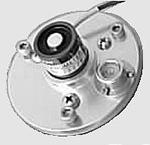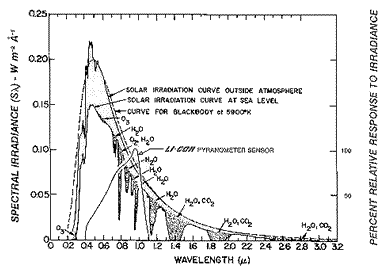
LI-COR pyranometer
The LI-COR pyranometer (LI-200R) measures global solar radiation. It is a photodiode covered by a plastic disk.
Specifications
| • | Calibration: against an Eppley PSP under natural daylight conditions, typical error is ±5%. |
| • | Sensitivity: 90 µA per 1000 W/m2. |
| • | Stability: < ±2% change over a 1 year period. |
| • | Response Time: 10µs. |
| • | Temperature Dependence: 0.15% per °C maximum. |
| • | Cosine Correction: corrected up to an 80° angle of incidence. |
| • | Azimuth: < ±1% error over 360° at 45° elevation. |
| • | Tilt: No error induced from orientation |
| • | Operating Temperature: -40 to 65°C. |
| • | Relative Humidity: 0 to 100%. |
| • | Detector: high stability silicon photovoltaic detector (blue enhanced). |
| • | Sensor Housing: weatherproof anodized aluminum case with acrylic diffuser and stainless steel hardware. |
Spectral responsivity

While thermopile based pyranometers such as an Eppley PSP have fairly uniform spectral response over the wavelength of interest, solar cell based pyranometers, such as the LI-COR have a marked spectral response to incident solar radiation. In the graph above, the LI-COR shows maximum sensitivity to wavelength in the 900 µ wavelengths and does not see an solar radiation with wavelengths over 1100 µ or under 400 µ.
© 2022, UO Solar Radiation Monitoring Laboratory.
|
Top of page Site map Solar data Instruments Publications |
Home page Search About our data Software tools |
Sponsors Contact us Monitoring stations Educational material |
Home page: solardata.uoregon.edu
